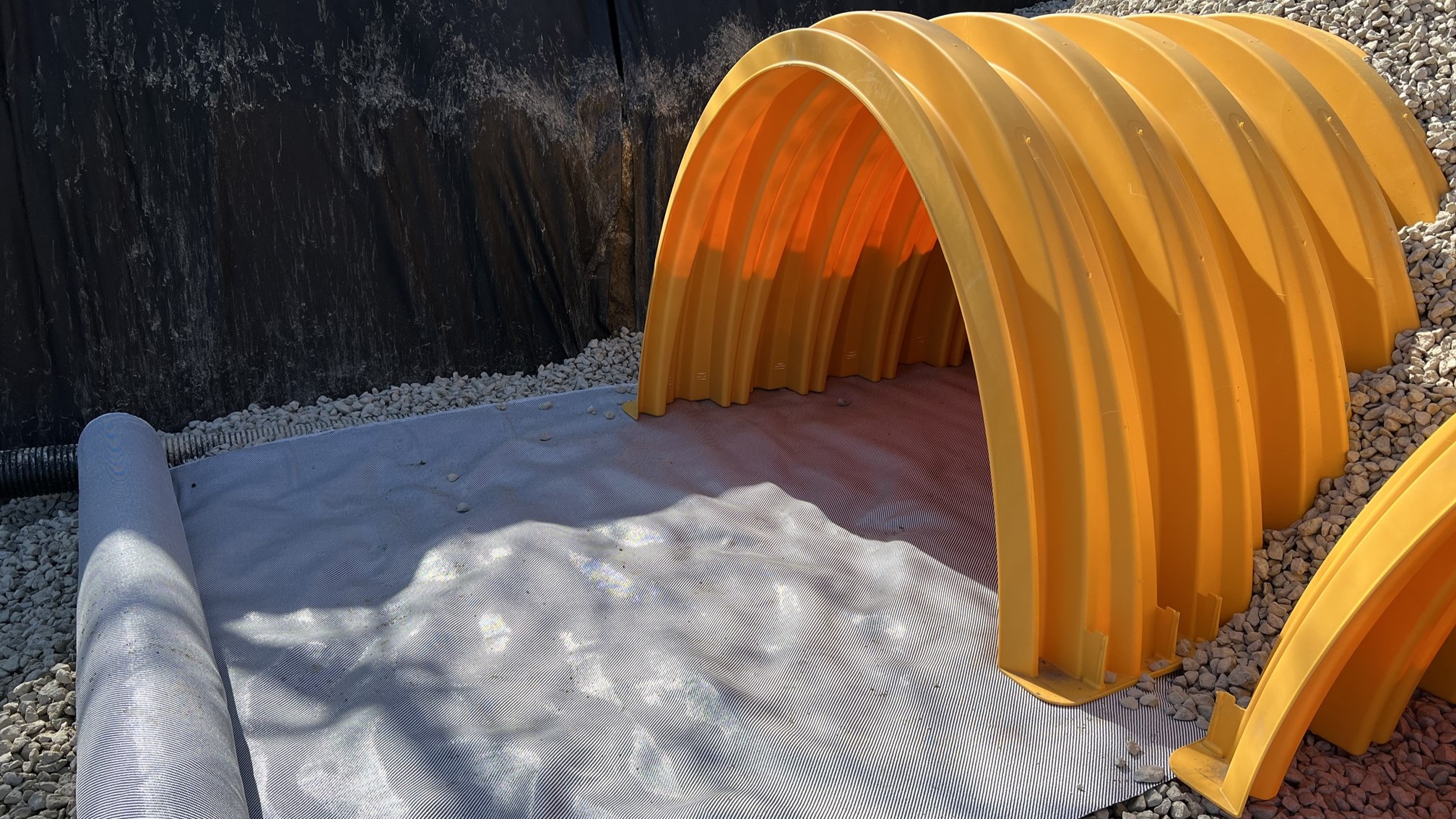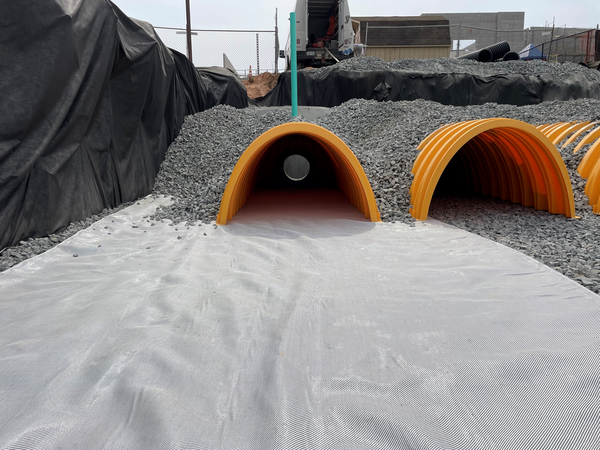
Stuart Crisp, UK manager of Advanced Drainage Systems (ADS), looks at how ‘good’ SuDS addresses water quality as much as water quantity when it comes to managing water down a ‘treatment train’.
Historically, driven by legislation, there’s a tendency to focus on water quantity – how to use SuDS to reduce or delay release of stormwater into sewers and prevent flooding. However, new legislation requires the additional focus on water quality. The SuDS treatment train considers water quality and prevention of pollution from stormwater runoff (alongside flood risk mitigation), with the level of treatment provided based on the anticipated levels and types of pollution.
A SuDS treatment (or management) train should start with prevention such as reducing impermeable surfaces, to reduce run-off and remove sources of pollution. Next comes source control, where rainfall is dealt with close to where it falls by infiltration-based elements such as soakaways, rain gardens and permeable pavements. Site control sees water managed within a local area, for instance directing water to a soakaway or infiltration device and then onto an attenuation pond or tank. Finally, regional control would see a system that could handle run-off from several sites, perhaps resulting in a detention basin or wetland.
The SuDS Manual, C753, published by CIRIA, prescribes a risk-based approach to designing SuDS for water quality. If pollution risks are deemed to be low, then SuDS designers can prioritise water quantity, amenity and biodiversity. If they are medium, then all considerations must be balanced. And if they are high, water quality evaluation must take precedence. It should however be noted that in all cases, including medium and low pollution risk sites, appropriate mitigation should be put in place to reduce the risk of pollution.
There is a range of water quality treatment measures that can be included in a SuDS train. Sometimes it is possible to use a completely natural SuDS train to deal with both water quantity and quality issues. At other times, the best solution combines natural and engineered SuDS elements, or may require proprietary manufactured elements only. This could be due to high levels of pollution loading or the space available.
There are four main types of pollutant that can be found in stormwater run-off: sediments, metals, hydrocarbons and nutrients. Sediments, often referred to in pollution mitigation as total suspended solids (TSS), is particulate matter. It includes tiny particles of soil, such as silt and clay, which have been dislodged by rainwater as it passes over the run-off surfaces.
Metals and metal compounds can be dissolved in run-off or attached to silts and sediments in the water. Copper and zinc are most commonly found in surface water in the UK but there can be cadmium and other toxic metals too. Although plants require very small amounts of copper and zinc to grow, higher concentrations can be damaging to them.

Hydrocarbon pollution comes with run-off from roads, car parks and areas where machines operate and are maintained, due to oil and fuel spills, tyre and brake wear. Changing climate means that rainfall events can be further apart but more intense, which can lead to higher concentrations of pollutants from roads, as they build up for longer before being washed away.
Nutrient pollution, usually nitrogen or phosphorous based, can come from sources such as run-off from agricultural land where fertiliser has been used or combined sewer overflows (CSOs), where sewage and surface water are mixed and discharged into bodies of water. They can lead to algal blooms, which reduces oxygen levels in the water and can negatively impact on aquatic habitats.
Capturing TSS pollution should generally be the focus of water treatment strategies in SuDS design since this removes both the solid particles and any pollution clinging to them. This can be done using a natural SuDS feature, such as planting for bioretention or a swale. Manufactured components such as filtration devices, silt traps or vortex separators can also be used upstream to remove solids before water is discharged into ponds, for instance.
Removal of sediment and solids is also important from a water quantity perspective. Build-ups reduce the capacity of a water storage element, whether natural or manufactured. How and when to remove sediment should be considered at the design stage and should be part of a planned maintenance regime.
Without a means of reducing suspended solids upstream of an attenuation device, sediment build-up within the device can reduce its efficiency over time. Some recently introduced underground arch-shaped SuDS attenuation devices have their own built-in systems for intercepting solids which are fast and simple to maintain.
Mitigation indices
The SuDS Manual sets out a simple method for dealing with water pollution risks, requiring the determination of pollution hazard indices for the area under consideration and then matching a SuDS device with matching mitigation indices.
In Table 26.2, the manual provides pollution hazard indices for a range of applications and for three types of pollution: TSS, metals and hydrocarbons. So, for example, for a busy public car park such as a supermarket or hospital, the index for TSS is 0.7, for metals is 0.6 and for hydrocarbons 0.7.
The next step is to identify a form of SuDS treatment that can provide the necessary mitigation indices, either as a single treatment stage or using a combination of components. The Manual has a table for that too, Table 26.3. However, this table only provides mitigation indices for natural SuDS components. The mitigation indices for the natural SuDS components were compiled by a team of experts, drawing information from a selection of published papers.
Mitigation indices for proprietary manufactured treatment systems must be provided by the manufacturer using recognised test methods and 3rd party verified data.
British Water has published a Code of Practice for the Assessment of Manufactured Treatment Devices Designed to Treat Surface Run-off. It uses rainfall time-series data for the UK to determine an appropriate treatment flow rates based on first-flush principles and uses a combination of two established test protocols – the German Deutsches Institut für Bautechnik (DIBt) and the New Jersey Corporation for Advanced Technology (NJCAT) from the US – to create the British Water test methods.
In 2022 British Water published a ‘how to’ guide, Applying The CIRIA SuDS Manual (C753) Simple Index Approach To Proprietary/Manufactured Stormwater Treatment Devices, which provides a calculation methodology to derive mitigation indices for TSS, metals and hydrocarbons based on the British Water Code of Practice, or the DIBt or the NJCAT, test results. This enables manufacturers of proprietary treatment products to have their mitigation indices published so that they can be considered as part of a SuDS management train.
British Water publishes a List of Assessed Surface Water Treatment Devices, details of which can be found on their website.
This article has been provided by Stuart Crisp at Advanced Drainage Systems – visit adspipe.co.uk




